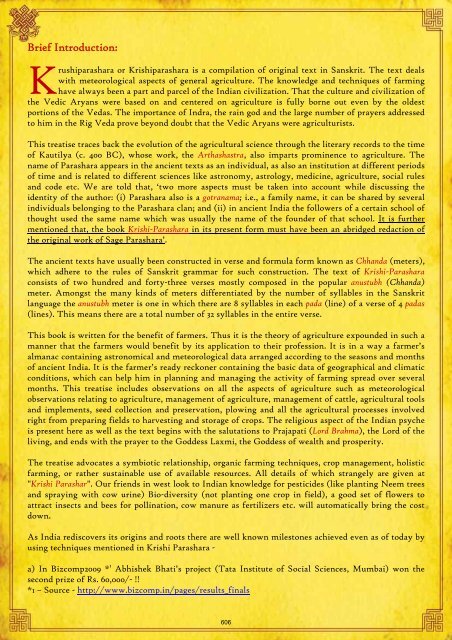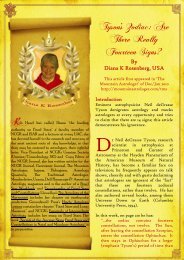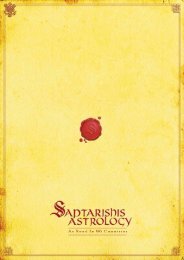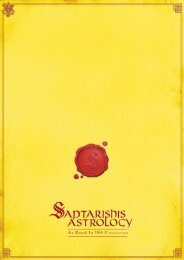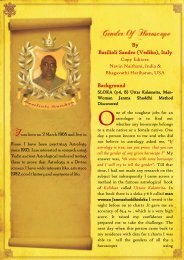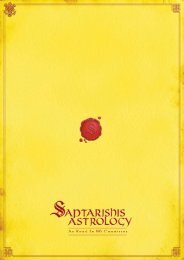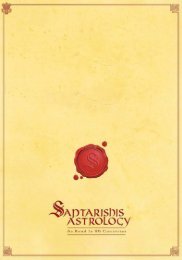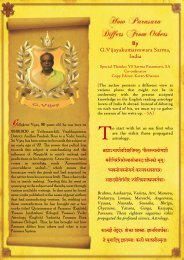SAVol7Dec09IndianCol.. - Saptarishis Astrology
SAVol7Dec09IndianCol.. - Saptarishis Astrology
SAVol7Dec09IndianCol.. - Saptarishis Astrology
- No tags were found...
Create successful ePaper yourself
Turn your PDF publications into a flip-book with our unique Google optimized e-Paper software.
Brief Introduction:Krushiparashara or Krishiparashara is a compilation of original text in Sanskrit. The text dealswith meteorological aspects of general agriculture. The knowledge and techniques of farminghave always been a part and parcel of the Indian civilization. That the culture and civilization ofthe Vedic Aryans were based on and centered on agriculture is fully borne out even by the oldestportions of the Vedas. The importance of Indra, the rain god and the large number of prayers addressedto him in the Rig Veda prove beyond doubt that the Vedic Aryans were agriculturists.This treatise traces back the evolution of the agricultural science through the literary records to the timeof Kautilya (c. 400 BC), whose work, the Arthashastra, also imparts prominence to agriculture. Thename of Parashara appears in the ancient texts as an individual, as also an institution at different periodsof time and is related to different sciences like astronomy, astrology, medicine, agriculture, social rulesand code etc. We are told that, ‘two more aspects must be taken into account while discussing theidentity of the author: (i) Parashara also is a gotranama; i.e., a family name, it can be shared by severalindividuals belonging to the Parashara clan; and (ii) in ancient India the followers of a certain school ofthought used the same name which was usually the name of the founder of that school. It is furthermentioned that, the book Krishi-Parashara in its present form must have been an abridged redaction ofthe original work of Sage Parashara’.The ancient texts have usually been constructed in verse and formula form known as Chhanda (meters),which adhere to the rules of Sanskrit grammar for such construction. The text of Krishi-Parasharaconsists of two hundred and forty-three verses mostly composed in the popular anustubh (Chhanda)meter. Amongst the many kinds of meters differentiated by the number of syllables in the Sanskritlanguage the anustubh meter is one in which there are 8 syllables in each pada (line) of a verse of 4 padas(lines). This means there are a total number of 32 syllables in the entire verse.This book is written for the benefit of farmers. Thus it is the theory of agriculture expounded in such amanner that the farmers would benefit by its application to their profession. It is in a way a farmer’salmanac containing astronomical and meteorological data arranged according to the seasons and monthsof ancient India. It is the farmer’s ready reckoner containing the basic data of geographical and climaticconditions, which can help him in planning and managing the activity of farming spread over severalmonths. This treatise includes observations on all the aspects of agriculture such as meteorologicalobservations relating to agriculture, management of agriculture, management of cattle, agricultural toolsand implements, seed collection and preservation, plowing and all the agricultural processes involvedright from preparing fields to harvesting and storage of crops. The religious aspect of the Indian psycheis present here as well as the text begins with the salutations to Prajapati (Lord Brahma), the Lord of theliving, and ends with the prayer to the Goddess Laxmi, the Goddess of wealth and prosperity.The treatise advocates a symbiotic relationship, organic farming techniques, crop management, holisticfarming, or rather sustainable use of available resources. All details of which strangely are given at"Krishi Parashar". Our friends in west look to Indian knowledge for pesticides (like planting Neem treesand spraying with cow urine) Bio-diversity (not planting one crop in field), a good set of flowers toattract insects and bees for pollination, cow manure as fertilizers etc. will automatically bring the costdown.As India rediscovers its origins and roots there are well known milestones achieved even as of today byusing techniques mentioned in Krishi Parashara -a) In Bizcomp2009 * 1 Abhishek Bhati’s project (Tata Institute of Social Sciences, Mumbai) won thesecond prize of Rs. 60,000/- !!*1 – Source - http://www.bizcomp.in/pages/results_finals606


